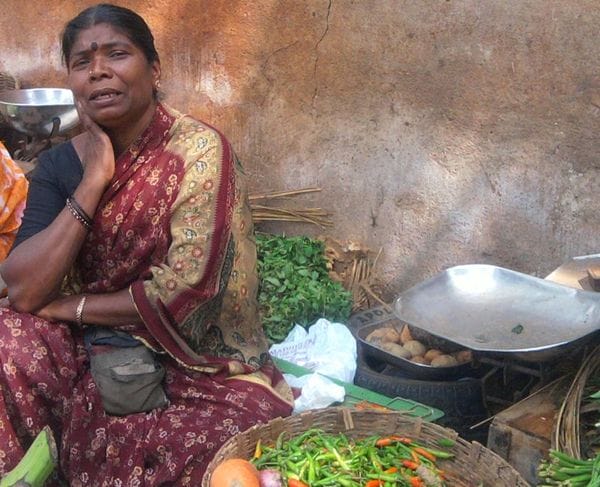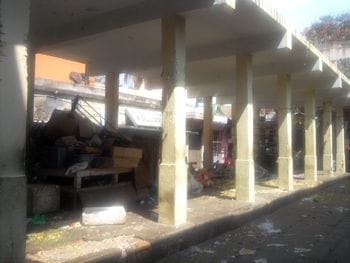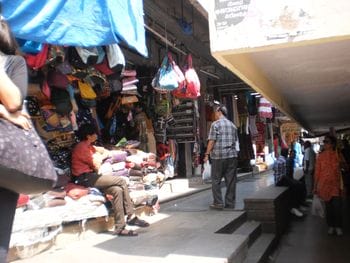
Susheela, a vegetable vendor at Gandhi Bazaar who was thrown out on Jan 23rd, is one of those who was allowed to return on February 9th by city councillor P N Sadashiva. Pic: Vijayalakshmi P.
After being thrown out by BBMP on January 23rd, vendors of Gandhi Bazaar, Basavanagudi have set up shops again on February 9th. "Yesterday the police constables chased us, but today they allowed us. But how about compensation?", asks Venkatappa, a 35-year-old florist. The vendors allege that the BBMP never gave them any notice.
The trader’s association of Gandhi Bazaar had a list which was used by the BBMP to allow eligible vendors back, says P N Sadashiva, Sunkenahalli ward Corporator, who visited the area on 9th.
Complaints from public about congestion, improper disposal of waste was said to be the decision behind the eviction. "I stay behind the complex near Gandhi bazaar, it hardly takes 15 to 20 minutes by walk to reach my place, when the markets are set up it takes one 40 minutes to reach my place" says Vinod, a Wipro employee.
Chief Minister D V Sadananda Gowda promised in the assembly on 6th February that the vendors would be allowed to continue to set up shops till alternative arrangements are made, the Deccan Herald reported.
Sunkenahalli ward Corporator P N Sadashiva however tells Citizen Matters that the number of vendors has been burgeoning from 200 to 400 making the market area very congested. "The act was not intentional, we did warn the vendors", he notes.

The alternative complex originally built for the Gandhi Bazaar vendors in Basavanagudi that did not pan out. Pic: Vijayalakshmi P.
There had been plans to relocate the vendors to a near by complex. But vendors are reluctant since they are not sure who gets to move in and who doesn’t. 35-year-old Parimala, a fruit vendor says, "They had asked some of us to shift to the complex. But we didn’t want to. We are more than 80 vendors, how can all of us fit in?"
"I have been here for 27 years. They did ask us to shift to the complex but the facilities provided by the BBMP inside was suffocating. The street is more spacious", says Ashok another a fruit vendor.
Jayanagar 4th block shopping complex is next
It is not just Gandhi Bazaar. Other traditional markets in the city are up for change, again with no smooth plans for vendors to manage the transition. Instead, they stare at uncertainty.
At Jayanagar 4th Block, BDA will soon pull down the existing shopping complex and build a swanky new mall. L&T has bagged the contract of Rs.120 crores to demolish and construct a multi-storeyed building here. Demolition is to commence in Apri. The new ‘mall’ is to have three floors for parking, apart from five storeys for shops.

Janata Bazaar in Jayanagar is a part of the 4th BDA shopping complex, that attracts lakhs of shoppers from around the city. BDA is all set to pull down the complex and rebuild a mall here starting April. Pic: Vijayalakshmi P.
As a stopgap, the defunct Puttanna theatre will be renovated to fit in the vendors first. "It is a two year project. We plan to demolish the theatre and build a new complex within 8 to 10 months. Then we are planning to renovate the rest," says Devanand, L&T architect. The vendors will be moved to the ‘mall’.
Not surprisingly, the vendors as always are the last ones to know of the authorities’ plans.
M Basavaraju, Merchants’ Association President says they got to know of the plans only through media. "We realised the demolition plans when a TV channel came to talk to the vendors about it. No officials have spoken to us regarding this," he says.
Road widening affects Malleshwaram street vendors
Malleshwaram meanwhile has vendors steeped in worry too. In 2010, H Ravindra, the then Standing Committee chairman of BBMP had suggesting widening of four roads in Malleshwaram. 8th cross, a busy shopping street was one of them. BBMP made announcements of vacating the stalls on the street and widening the roads.
Two years on the vendors are still unsure of getting another space for setting up shops or whether they can come back once the road has been widened. ⊕
Related Articles
Sometimes wonder if they should ban all bus traffic on Gandhi Bazaar and get those to go through National College and Vani vilas road. People can also walk about in peace instead of being hassled non-stop by motorists.
Why is it always the vendors and pedestrians who have to give way when traffic increases?
They have a valid point on the cleanliness though. They really need to enforce some standards on that. Ideally I would like to see those vendors still there, but with wider footpaths and very minimal traffic on the main road. Even better if they can make it a complete walkway from the DVG road junction to Tagore circle.